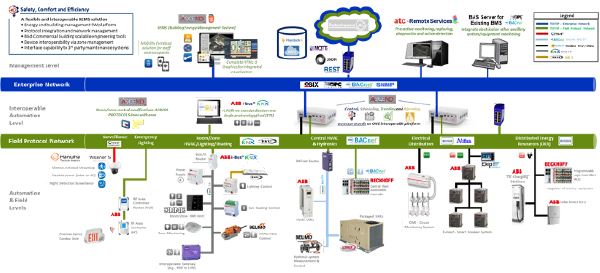
By Philip R. Juneau, ATC.
A little over six years ago, I was honoured to co-author an article entitled Active Site for the longstanding publication ABB Review. This explained how renewable energy, together with on-site generation and storage on an industrial or large campus site (i.e. microgrid), can provide energy independence whilst using the energy utility’s connection to source energy when needed, or offload its surplus. Looking back over the years leading up to the present, the electrical power grid is truly evolving into a smart grid, ready to supply power to evolving smart cities; break this down into manageable entities or blocks in a city or geographic region and you have what is called multiple ‘active sites’. An active site can completely control and optimise its own microgrid, having individually-complex energy loads, and its interface to the dynamic macro- (power) grid. Its main purpose is to ensure its own optimisation of energy usage and costs whilst permitting the microgrid to participate fully in what is known as the smart grid. The power rating of active sites ranges between 100kW and 50MW.

The interconnection and communicational aspects between the site and the energy provider must be completely aligned both technically and commercially. It’s a simple, yet challenging matching of supply-side and demand-side management perspectives, which is much easier said than done. What this article aims to convey is that active site technology that exists today is ever more advanced and ready to implement effectively.
Active site in reality
In reality, an active site is a feasible endeavour for most major energy-consuming campuses, complexes or industrial facilities, as it comprehensively has all of the ingredients for an intelligent infrastructure solution; a main one being its base energy profile i.e., energy usage over time. This means that there is a steady base load for reliable energy usage, therefore on-site generation and/or renewables can optimise your energy and carbon profiles from a cost and emissions standpoint respectively.

The energy demand (i.e. power draw) over time must be evaluated down to the load/equipment level, both building technology and core-business related. Having such an equipment list with the hours of operation is an asset in itself, in order to begin your journey to becoming an active site. Naturally, this must be carefully ascertained together with your building operations and staff in order to ensure that the buildings are safe and comfortable prior to any adverse effects from efficiency measures.
Critical aspects to unify infrastructure
To unify the complexity within the building infrastructure, it is best to begin initially with your energy profile, as stated earlier. By generating an equipment list, it is recommended that you capture the following information for each equipment/component:
- Location.
- Power variables: horsepower (HP) or power (W), voltage (V), full load amperage (FLA).
- Time of usage (specific start and stop, i.e. running times).
- Area servicing (e.g. HVAC air handling unit serving a medical clinic area).
- Manufacturing date of equipment (age).
- Controls or interfaces for monitoring and controlling.
- General notes.
Note: Actual values via a meter or other data capturing device is ideal.
Once the list is created, you can determine the significant portions of your facility/campus energy load to look further into potential solutions. First, identify the connectivity of your facility or building energy management system (BEMS), as this is the cornerstone to an intelligent building/facility or campus. Second, ensure the use of open building controls protocols, such as BACnet and KNX which are also standards in the industry. Also, try to use IP communication for these i.e. BACnet/IP and KNX/IP, as this both streamlines communication and improves reliability. Both points are the most basic and important ones to consider, as they provide the ability to scale and modify/adapt in the future – full stop.
The solution in reality
As already mentioned, an active site is a feasible endeavour, as it contains all the ingredients for an intelligent infrastructure solution. So, let’s talk about integrating the ingredients, namely energy consuming equipment and infrastructure. What ties all of these together is a unification of building technology open protocols and standards integrated under one intelligent, IP-convergent SCADA (Supervisory Control and Data Acquisition) platform.
Using KNX sensors and switches for occupant interfaces and DIN-rail controls for localised equipment control whilst using IP-based BACnet controllers for central applications, it becomes extremely straightforward to acquire, automate and manage your building data.

The solution described above does not have to be done all at once. A scalable solution which can go through many iterations within each lifecycle is feasible. What is important is to focus on the priority areas within your facility or campus and keep the following technical measures in mind whilst adhering to the open protocol technology approach mentioned above:
- Time of usage shift to off-peak hour rates.
- Optimal start/stop of equipment.
- Peak demand limiting for manageable loads/equipment.
The following active site implementation process comes from the aforementioned article and should be used as a guideline, even in smaller project iterations. What is important is to start somewhere, so monitoring data together with analytics can also change user behaviour and building/facility/campus operations.

Summary
If you happen to be involved in the operation of a larger facility, campus or industrial facility with a baseload operation, then you’re an active site candidate! The technology is available, and you can begin with simple monitoring of your baseline energy profile to better understand where to begin and what to focus on. All it takes is dedication, transparency and well-spent resources to save money and help us all to reach a net-zero infrastructure.
Philip R. Juneau is Chief Commercial Officer for Automated Technology Company (ATC), and Vice President of the KNX USA National Group. ATC’s mission is to transform today’s buildings into tomorrow’s net-zero infrastructure by ensuring the highest levels of safety, comfort and efficiency for the overall well-being of its occupants and the overall environment.











